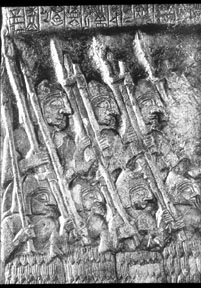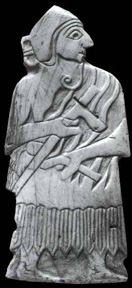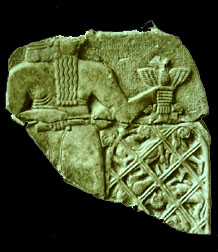|
Around 4000 B.C. city-states began
to develope in ancient Mesopotamia. With their growth, conflicts developed among them.
Warfare often arose as the result
of wealth, control of the Tigris and Euphrates for transportation and irrigation, boundary disputes, and the need to acquire
luxury goods such as timber, stone and metals.
The almost constant occurrence of
war among the city-states of Sumer for two thousand years spurred the development of military technology and technique far
beyond that found elsewhere at the time.
Although it is not the earliest conflict,
the first war for which there is any detailed evidence occurred between Lagash and Umma in 2525 B.C., two Sumerian cities
located eighteen miles apart.
For generations, Lagash and Umma contested
the possession and agricultural usufruct of the fertile region of Guendena. As the result of the violation of an earlier boundary
treaty by Umma, Lagash went to war with Umma. In this war Eannatum of Lagash defeated the king of Umma.
The importance of this war to the
military historian lies in a commemorative stele that Eannatum erected to celebrate his victory. The stele was excavated in
fragments and is known as The Stele of Vultures because one of the fragments depicts vultures carrying off the heads of the
defeated troops. The stele represents the first important pictorial of war in the Sumerian period.

|
| Stele of Vultures |

|
| Fragment showing vultures carrying heads |
This first historical evidence of army organization comes
from the Middle Eastern Sumerian empire in Babylonia. This stele from the 3rd millennium BC shows
spearmen of
Lagash in copper helmets behind a wall of leather shields and heavy cloaks carrying short spears sweeping over soldiers from
neighboring Umma. The lower panel shows triumphant infantrymen marching behind the chariot of King Ennatum. The inscription
describes the battle and its outcome. This image presages the phalanx used by the Greeks so effectively in the Persian Wars
and the battles of Alexander the Great against the Persians although it predates these battles by at least 2000 years

|
| Fragment showing Lagash phalanx |
The lower left portion of the above stele fragment is shown below. It depicts
spear bearers. They, as well as the soldiers in the phalanx, wear helmets. This is the first historical evidence of soldiers
wearing helmets. The helmets were probably made of copper and had a leather lining or cap underneath. Similar helmets were
excavated at the Royal Tombs of Ur. Such helmets rendered the once formidable battle mace
ineffective.

|
| Spear soldiers wearing helmets |
From the tomb
of Meskalam-dug is this heavy gold helmet exquisitely engraved to reproduce the curls of his hair and the bun at the back
of his head. Royal Cemetery of Ur, about 2500 B.C. Iraq Museum, Baghdad.


|
| Pear shaped mace head made of limestone circa 3000 B.C.. Found in Mesopotamia. |
The first military application of the wheel is depicted on the stele which shows
Eannatum riding in a chariot. The Sumerian invention of the chariot ranks among the major military innovations in history.
The earlier Standard of Ur also depicts the Sumerian development of the chariot. These chariots were primarily four wheeled
vehicle drawn by onagers (wild asses). There were very cumbersome and were probably used for battlefield transportation rather
than attack vehicles.

|
| Ennatum riding in chariot |

|
| Sumer chariots from Standard of Ur |

|
| Reproduction of early Sumerian war chariot |

|
| From Soldatini online |

|
| Sumerian War Wagon |
The lower palette of the Stele of Vultures shows the king holding a sickle-
sword which became the primary infantry weapon of the Egyptian and Biblical armies at a much later date. It is believed that
the Sumerians invented this important weapon sometime around 2500 B.C.

|
| sickle-sword |
Both the Vulture Stele and the Royal Standard of Ur show soldiers wearing what
appear to be armored cloaks. They were probably made of thin leather with metal disks with raised centers or spines sown on
the cloaks. These cloaks afforded some protection against the weapons of the day such as the copper socket axe.

|
| Sumerian body armor drawing, 2500 B.C. |

|
| From Soldatini online |

|
| Copper blade socket axe excavated at Royal Tombs of Ur |
When the Sumerians
introduced the use of overlapping plate body armor, it was quickly followed by the development of the bronze socket axe. Sumerian
axes by 2500 B.C. show a change in design with the narrowing of the blade and bringing it more to a point so that it could
pierce bronze plate armor. This became one of the most devastating weapons of the ancient world.

Above are bronze
socketed axeheads, all from a tomb at Til Barsip, illustrating the variety of blade shapes in use at the end of the third
millennium B.C. capable of armor piercing. The axehead at the right has animal heads at the rear of the socket. (All examples
are now in the Louvre.)
Below is a small
plaque of engraved shell from the ancient city of Mari on the Euphrates showing a warrior of about 2500 BC with metal helmet,
battle-axe and sickle-sword. Musée National de Louver, Paris.

An interesting
fragment from the Stele of Vultures shows Nin-girsu, the god of Lagash, grasping a net in which his diminutive enemies have
been caught. Here, the glory is given to the god.

|
